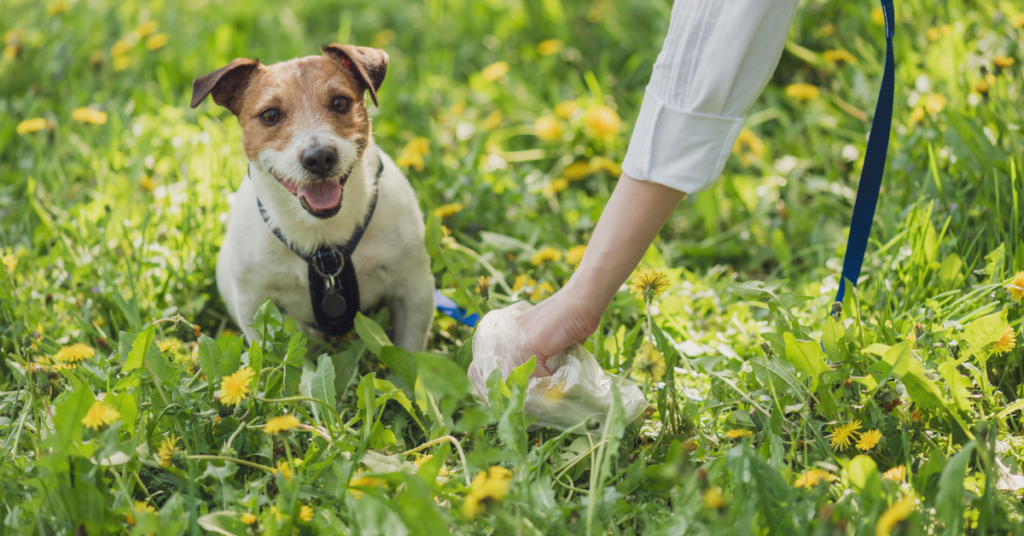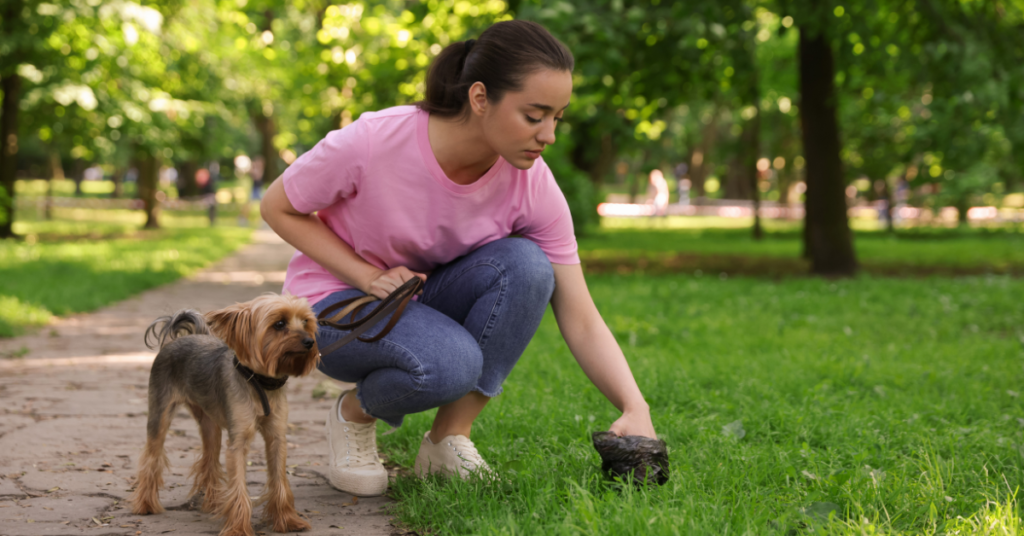Poop is a great indicator of your dog’s overall health and often the first tell-tale sign that things aren’t as they should be.
Healthy dog poop should have a chocolate brown color, play-doh consistency and not smell overly offensive or putrid.
Getting to know what healthy dog poop looks like can keep you, as a dog parent, on top of your dog’s health.
What Should Healthy Dog Poop Look Like?
To determine if something is up, you need to know what healthy dog poop looks like in comparison. It may not be pleasant, but keeping an eye on what your dog is dispensing and getting to know what’s healthy and normal will keep you on top of things as a dog parent!
Color
Color is one of the best ways to determine if you have healthy dog poop. Here are the various colors you might see and what they mean:
- Medium Brown: If your dog’s poop is somewhere in the range of medium brown without falling alarmingly dark (into black category) or oddly light (into yellow, this is considered a normal color. The shade may vary depending on the dog but think chocolate brown.
- Green: Green is considered abnormal, but could be for a range of reasons. The most common reason for green poop is that your dog eats grass, though it could also be because of a more serious (but rarer) condition like gallbladder disease.
- Yellow: Yellow or orange dog poop can indicate that there’s an issue with digestion or something wrong with the liver.
- White: White can indicate too much calcium and perhaps some constipation.
- Dark Red or Black: Dark red or black can indicate blood in the poop, which can be a serious issue depending on the root cause.
What to Do if There Is Blood in Your Dog’s Stool
While blood in your dog’s poop can be alarming, there are some potentially minor reasons it’s there such as a food allergy, some irritation somewhere in the dog’s rear end, or parasites. However, there are also some potentially more serious reasons, such as:
- Canine parvovirus, an infectious disease that can potentially be lethal
- A foreign body obstruction which may need surgery to correct and can also be dangerous if left untreated
- A stomach ulcer
- Blood clotting disorders
- Parasites
- Tumors in the digestive tract
Because there’s such a wide range of possibilities in terms of the cause, blood in your dog’s stool often calls for a vet visit. Taking a stool sample with you can help your veterinarian diagnose what the root cause is and make sure your dog gets the appropriate treatment.

Consistency
Dog poop consistency is another key indicator as to whether it’s healthy or not. The ideal consistency should be like Play-Doh, and not split into small pieces. If you notice the consistency is anything else, it should be monitored closely. An unhealthy dog poop consistency would include:
- Hard Pellets: These can indicate constipation in dogs.
- Soft Logs: If the poop doesn’t hold shape when picked up and has soft logs, this means the dog has mild diarrhea. Mild causes are usually uncomplicated and should resolve on their own in 1-2 days.
If the dog poop consistency is very runny and water-like, then you should see a veterinarian right away. Your dog runs the risk of dehydration with diarrhea this severe, especially if it’s also accompanied by vomiting. Getting ahead of this by ensuring your dog has enough liquids and determining the underlying cause is key.
Should Your Dog’s Poop Have a Slimy Coating?
You may notice that while your dog’s poop seems to be a healthy consistency, it comes with a slimy coating. This means there’s some mucus present.
A little mucus in dog poop is normal but, when enough of it is present to create that slimy coating, it’s likely your dog’s bowls are inflamed. This is usually caused by some sort of upset in the digestive tract that may have a bigger root cause and, if present for more than 1-2 days, you should talk to your vet.
This is also true if it’s accompanied by other symptoms such as vomiting, lethargy, blood in the poop, etc.
Frequency
Adult dogs usually poop around 2-3 times per day, but this can vary based on how often your dog eats, the size and breed of your dog, and their overall toilet habits. If they’re consistent, and it isn’t too far outside of the normal (for example, you’ll see more frequent dog poop from puppies!), then there’s usually no reason to be concerned.
Dogs usually need to poop around 8-12 hours after eating their last meal because of their digestive cycle so if you’re consistent with feeding times, chances are, your dog will get on a poop schedule and you’ll be able to accurately predict when they need to go.
Having a dog poop schedule isn’t only handy for routine and your life together, but it can help you quickly spot if anything out of the norm happens so you can jump on it quickly.
This routine, for example, may be disrupted if your dog has diarrhea. Dogs can’t hold it for as long when they have diarrhea and, once the diarrhea is cleared up because their system has been purged, they may go a day or so without pooping before they get back to normal.
Smell
Dog poop never smells pleasant, unfortunately, even healthy puppy poop—but you shouldn’t be dealing with excessively stinky poop either. While there will be a noticeable odor when your dog has to let one go, anything that smells wildly more offensive than usual or gives off a particularly putrid odor requires some attention.
Dog poop that suddenly smells worse than usual will likely be accompanied by off-color or runny poop, signaling other issues.
It could also smell worse after switching your dog to a new diet while they get used to the new food. When deciding if the smell is a cause for concern, you should weigh up all the surrounding factors and any changes in their life as well as the dog poop itself.

When to Visit the Vet
Even though 28% of pet parents don’t clean up after their dog, it’s not just the environment they need to worry about—it’s the fact they might be missing vital clues that their dog needs medical attention, or at least a little extra attention until they’re back to normal.
While a change in the smell, consistency, and color of dog poop might indicate there’s something wrong, the most important thing to decide is when you should be closely monitoring vs. when you should take your dog to the vet.
If it’s a brief bout of diarrhea where the color and consistency aren’t too far from normal, you can monitor your dog closely and ensure it doesn’t get any worse.
However, experts recommend taking your dog to the vet if you notice any of the following:
- A lack of appetite
- Lethargy
- Black or tarry dog poop (indicating a lot of blood)
- Excessively watery dog poop where there are no solids at all
- Vomiting alongside the diarrhea
- Diarrhea that lasts more than 48-72 hours
The main reason for this is that while some issues are taken care of with some rest and a good probiotic, the underlying reason for more severe cases might be serious and need treatment to resolve. It could become worse if a veterinarian doesn’t get involved.
Another reason is that diarrhea will dehydrate your dog, especially if accompanied by vomiting, and this can cause further problems. Diarrhea causes everything to move too quickly through a dog, meaning excess water isn’t absorbed into the body as it usually would be.
A dog that’s dehydrated for too long can even have organ failure.
How to Collect a Stool Sample
If you do have to take your dog to the vet, a stool sample can be hugely helpful in their diagnosis. Parasites, for example, can be diagnosed through the stool, and seeing exactly how abnormal it is will help the vet in their investigation.
To properly collect a dog poop sample, invert a clean plastic bag over your hand and use it to grab the poop. Dispense it into a thin, shallow, and clean container to make sure it doesn’t get contaminated, and seal it tightly.
Fresh poop is always best for the vet. Make sure the poop you take to the vet is from the same day (preferably only a few hours or less before their appointment) for the most accurate results.

Final Thoughts
Dog poop, while unpleasant, is one of the best indicators of your pup’s health. Clean up after your dog so you can keep an eye on the color, consistency, and smell of what they’re putting out, and act quickly if anything about it is abnormal—your best friend will thank you for it!
FAQs
What Does Unhealthy Dog Poop Look Like?
There’s no one appearance of unhealthy dog poop, and it can look like any number of things, but some good indicators are an unusually light or dark color, a foul odor, or a soft or even runny texture.
How Do I Know If My Dog’s Poop Is Normal?
Keeping an eye on your dog’s poop so you have a baseline and then checking it on a regular basis is the best way to know if the dog poop is normal. If your dog is new to you and you aren’t sure what’s normal for them, check that the color is a medium brown, the logs are well-formed, and the smell isn’t excessively bad!
Is it Better for Dog’s Poop to be Hard or Soft?
Dog poop should be hard enough that it holds its shape, but not so hard that it forms pellets (which can be an indicator of constipation). Too far in either direction can be a problem—you should be able to pick up dog poop without it falling apart, but it should still feel soft.
